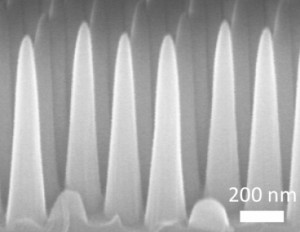Cutting the cost for making solar cells could be a step in the right direction for more widespread adoption. At any rate, that seems to be the motivation for Dr. Felipe Chibante of the University of New Brunswick and his team as they’ve worked for the past three years or so on cutting production costs for fullerenes (also known as, buckminsterfullerenes, C60, and buckyballs). From a Dec. 23, 2015 article by Michael Tutton for Canadian Press,
A heating system so powerful it gave its creator a sunburn from three metres away is being developed by a New Brunswick engineering professor as a method to sharply reduce the costs of making the carbon used in some solar cells.
Felipe Chibante says his “sun in a can” method of warming carbon at more than 5,000 degrees Celsius helps create the stable carbon 60 needed in more flexible forms of photovoltaic panels.
…
Tutton includes some technical explanations in his article,
Chibante and senior students at the University of New Brunswick created the system to heat baseball-sized lumps of plasma — a form of matter composed of positively charged gas particles and free-floating negatively charged electrons — at his home and later in a campus lab.
According to a May 22, 2012 University of New Brunswick news release received funding of almost $1.5M from the Atlantic Canada Opportunities Agency for his work with fullerenes,
Dr. Felipe Chibante, associate professor in UNB’s department of chemical engineering, and his team at the Applied Nanotechnology Lab received nearly $1.5 million to lower the cost of fullerenes, which is the molecular form of pure carbon and is a critical ingredient for the plastic solar cell market.
Dr. Chibante and the collaborators on the project have developed fundamental synthesis methods that will be integrated in a unique plasma reactor to result in a price reduction of 50-75 per cent.
Dr. Chibante and his work were also featured in a June 10, 2013 news item on CBC (Canadian Broadcasting Corporation) news online,
Judges with the New Brunswick Innovation Fund like the idea and recently awarded Chibante $460,000 to continue his research at the university’s Fredericton campus.
Chibante has a long history of working with fullerenes — carbon molecules that can store the sun’s energy. He was part of the research team that discovered fullerenes in 1985 [the three main researchers at Rice University, Texas, received Nobel Prizes for the work].
He says they can be added to liquid, spread over plastic and shingles and marketed as a cheaper way to convert sunlight into electricity.
“What we’re trying to do in New Brunswick with the science research and innovation is we’re really trying to get the maximum bang for the buck,” said Chibante.
As it stands, fullerenes cost about $15,000 per kilogram. Chibante hopes to lower the cost by a factor of 10.
…
The foundation investment brings Chibante’s research funding to about $6.2 million.
Not everyone is entirely sold on this approach to encouraging solar energy adoption (from the CBC news item),
The owner of Urban Pioneer, a Fredericton [New Brunswick] company that sells alternative energy products, likes the concept, but doubts there’s much of a market in New Brunswick.
“We have conventional solar panels right now and they’re not that popular,” said Tony Craft.
“So I can’t imagine, like, when you throw something completely brand new into it, I don’t know how people are going to respond to that even, so it may be a very tough sell,” he said.
Getting back to Chibante’s breakthrough (from Tutton’s Dec. 23, 2015 article),
The 52-year-old researcher says he first set up the system to operate in his garage.
He installed optical filters to watch the melting process but said the light from the plasma was so intense that he later noticed a sunburn on his neck.
…
The plasma is placed inside a container that can contain and cool the extremely hot material without exposing it to the air.
The conversion technology has the advantage of not using solvents and doesn’t produce the carbon dioxide that other baking systems use, says Chibante.
He says the next stage is finding commercial partners who can help his team further develop the system, which was originally designed and patented by French researcher Laurent Fulcheri.
Chibante said he doesn’t believe the carbon-based, thin-film solar cells will displace the silicon-based cells because they capture less energy.
But he nonetheless sees a future for the more flexible sheets of solar cells.
“You can make fibres, you can make photovoltaic threads and you get into wearable, portable forms of power that makes it more ubiquitous rather than having to carry a big, rigid structure,” he said.
The researcher says the agreement earlier this month [Nov. 30 – Dec. 12, 2015] in Paris among 200 countries to begin reducing the use of fossil fuels and slow global warming may help his work.
…
By the way, Chibante estimates production costs for fullerenes, when using his system, would be less that $50/kilogram for what is now the highest priced component of carbon-based solar cells.
There is another researcher in Canada who works in the field of solar energy, Dr. Ted Sargent at the University of Toronto (Ontario). He largely focuses on harvesting solar energy by using quantum dots. I last featured Sargent’s quantum dot work in a Dec. 9, 2014 posting.
